ai對話機器人實現方案
A couple of folks from Obviously.ai contacted me a few days back to introduce their service — a completely no-code machine learning automation tool. I was a bit skeptical at first, as I always am with supposedly fully-automated solutions, but I decided to give it a try. I’ll share my thoughts in this article, and discuss if service is worth the try.
幾天前,來自Obviously.ai的幾個人聯系了我,介紹他們的服務-完全無代碼的機器學習自動化工具。 一開始我有點懷疑,因為我一直都在使用所謂的全自動解決方案,但是我決定嘗試一下。 我將在本文中分享我的想法,并討論服務是否值得嘗試。
I find it somewhat difficult to watch tools like this one automate machine learning, and decrease the need for machine learning engineers in small and medium-sized companies. The reasons are many, but the biggest is that the purpose of machine learning was to automate other professions, but we’ve managed to automate machine learning with machine learning. Good job.
我發現觀看這種自動化機器學習的工具有點困難,并減少了中小型公司對機器學習工程師的需求。 原因有很多,但最大的原因是機器學習的目的是使其他專業自動化,但是我們已經設法通過機器學習使機器學習自動化。 做得好。
It’s not entirely a bad thing, as we can now focus on more important things, instead of fitting algorithm after algorithm, with the aim of squeezing that additional 0.15% accuracy.
這并不完全是一件壞事,因為我們現在可以專注于更重要的事情,而不是逐個算法進行擬合,以期提高0.15%的精度。
So, what is Obviously AI?
那么,什么是AI?
Hero section on their home page explains it pretty well:
他們主頁上的“英雄”部分對此進行了很好的解釋:
The total process of building ML algorithms, explaining results, and predicting outcomes in one single click.
一次單擊即可構建ML算法,解釋結果和預測結果的總過程。
After playing around with it for a bit, I must say that it delivers. So, what’s the catch? Good question. We are accustomed to quite pricy solutions in this day and age, and ObviouslyAI is not an exception. It has a more than decent free plan, limited to CSV files only with no more than 50,000 rows. That’s more than enough for basic exploration.
在玩了一段時間之后,我必須說它交付了。 那么,有什么收獲呢? 好問題。 在當今時代,我們已經習慣了價格昂貴的解決方案, 顯然AI也不例外。 它有一個不錯的免費計劃,只限于CSV文件(不超過50,000行)。 對于基礎探索而言,這綽綽有余。
I’m on the Free plan currently, and it’s more than enough for my needs. We’ll now go through a concrete example of training a machine learning model with this service, and you’ll see how stupidly easy the entire thing is.
我目前處于“免費”計劃中,已經足夠滿足我的需求。 現在,我們將通過使用此服務來訓練機器學習模型的具體示例,您將看到整個過程多么簡單。
Before we start, I want to make a quick disclaimer. Even though folks at ObviouslyAI asked me to review their service, I am in no way affiliated with them, nor will I try to convince you to switch to a paid account. Everything I say is based purely on the Free version.
在開始之前,我想快速聲明一下。 即使ObviouslyAI的人員要求我審查他們的服務,但我絕不隸屬于他們,也不會說服您切換到付費帳戶。 我所說的一切完全基于免費版本。
注冊和設置 (Registration and setup)
It was at this step that the first strange thing happened. I’ve gone ahead and opened the Signup page, and was prompted to enter an email. What was strange is that my personal Gmail account wasn’t eligible for registration.
正是在這一步,第一件事發生了。 我已經打開了“注冊”頁面,并被提示輸入電子郵件。 奇怪的是我的個人Gmail帳戶不符合注冊條件。
A business email account is a must.
企業電子郵件帳戶是必須的。
I have a business email account from my company, so that wasn’t an issue, but might be a dealbreaker for some of you. I can’t verify if the same thing happens for other email providers, but Gmail doesn’t work at this point in time. Strange.
我有一個來自公司的企業電子郵件帳戶,所以這不是問題,但對于某些人來說可能是一個大問題。 我無法驗證其他電子郵件提供商是否也發生了同樣的事情,但是Gmail目前無法正常工作。 奇怪。
Nevertheless, I’ve completed the registration process and verified the email address, and then I was presented with a nice-looking dashboard:
不過,我已經完成了注冊過程并驗證了電子郵件地址,然后看到一個漂亮的儀表板:
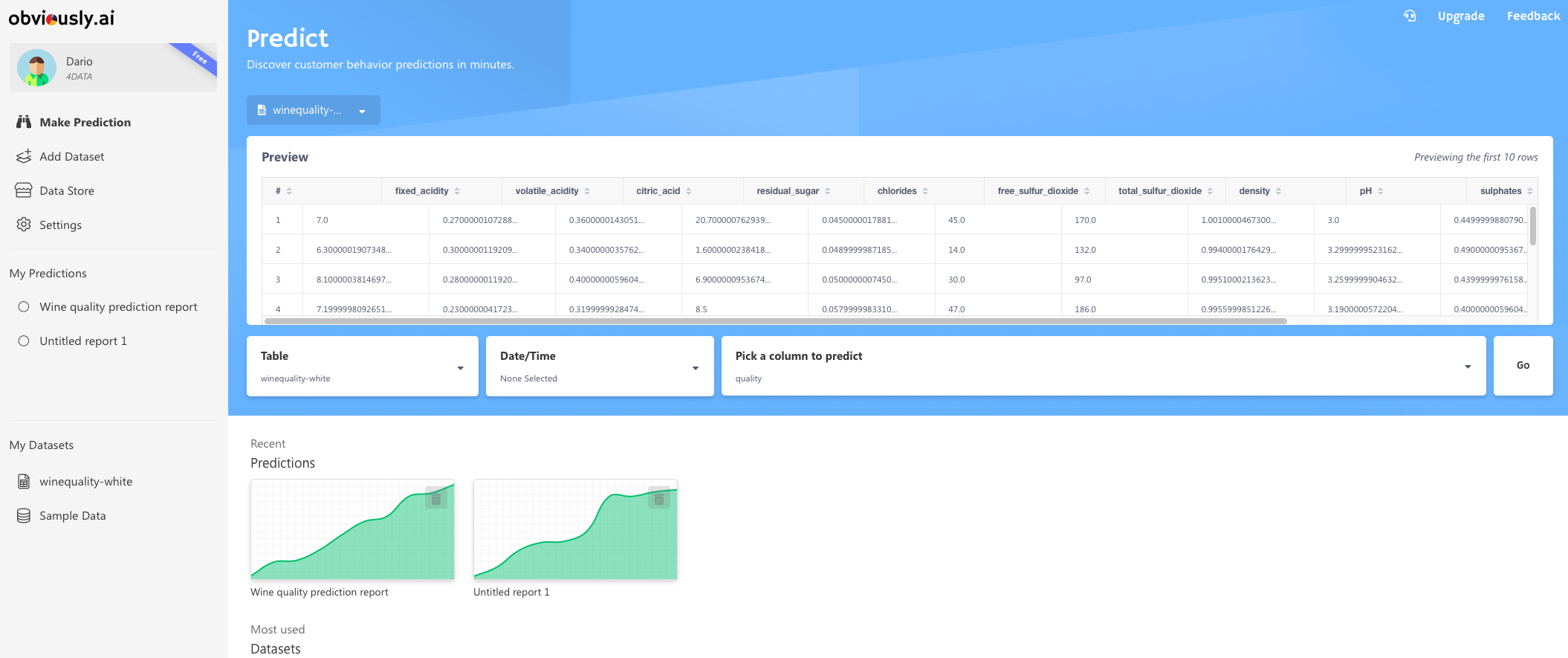
There are some sample datasets built-in, but I guess those work flawlessly. We won’t be using those for our machine learning tasks, and will instead be using a well-known Wine dataset. Let’s build a model in the next section.
有一些內置的示例數據集,但我想它們可以完美地工作。 我們不會將這些用于機器學習任務,而是將使用眾所周知的Wine數據集 。 讓我們在下一部分中構建模型。
建立模型 (Building a model)
This step is stupidly simple, as stated earlier. The first to do is to upload the dataset. We’ll use the Add Dataset button on the sidebar to do so:
如前所述,這一步驟非常簡單。 首先要做的是上傳數據集。 我們將使用邊欄上的“ 添加數據集”按鈕執行此操作:
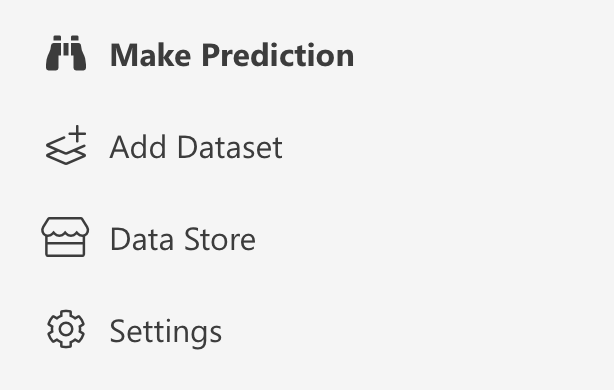
Once clicked, a modal should appear on which we can drag and drop (or click to upload) our dataset. Keep in mind these constraints (free version):
單擊后,將出現一個模態,我們可以在其上拖放(或單擊以上傳)我們的數據集。 請記住以下限制 (免費版本):
- File size must be less than 25MB 檔案大小必須小于25MB
- There must be at least 1000 rows 必須至少有1000行
- There must be at least 5 columns 必須至少有5列
Our wine dataset passes all of those conditions, so we can upload it:
我們的葡萄酒數據集通過了所有這些條件,因此我們可以上傳它:
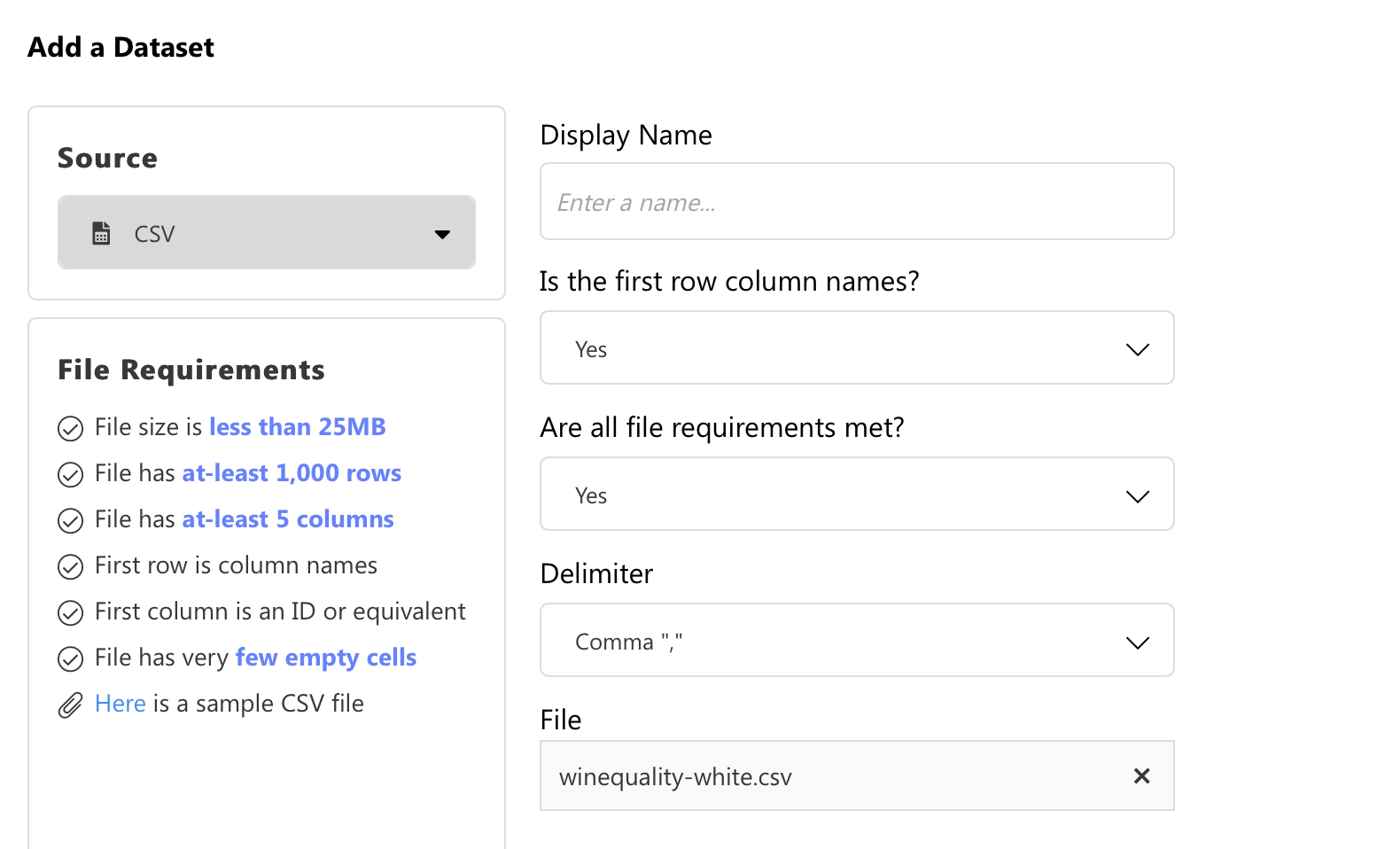
Once the upload is finished, we’ll get to this well-presented exploration modal:
上傳完成后,我們將進入這個精心呈現的探索模式:
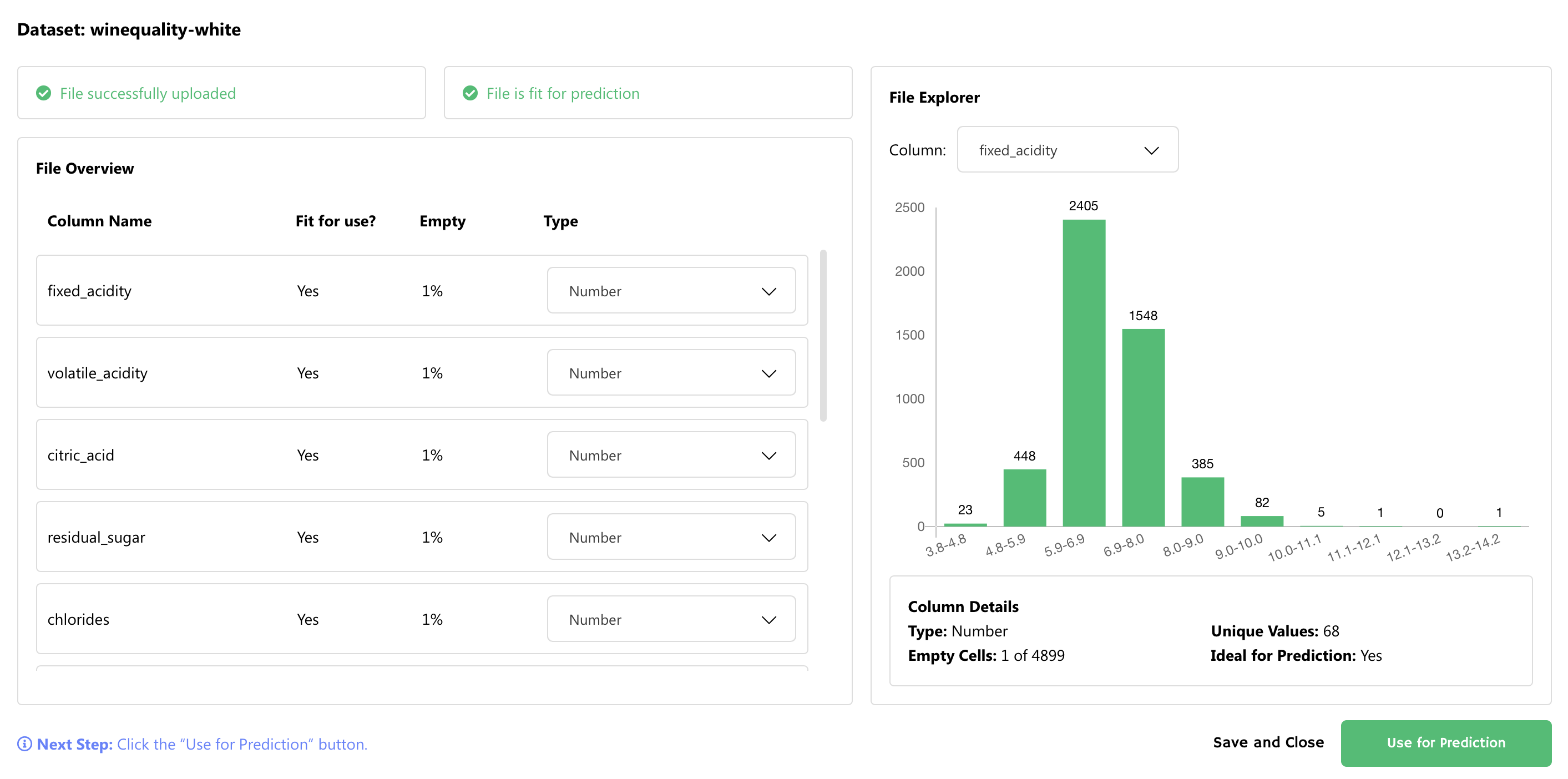
From here, we just need to follow the instructions. Let's click on the Use for Prediction button. We’re almost finished with the preparation. In the next modal window we just need to choose the target variable:
從這里開始,我們只需要按照說明進行操作即可。 讓我們單擊“ 用于預測”按鈕。 準備工作差不多完成了。 在下一個模態窗口中,我們只需要選擇目標變量:
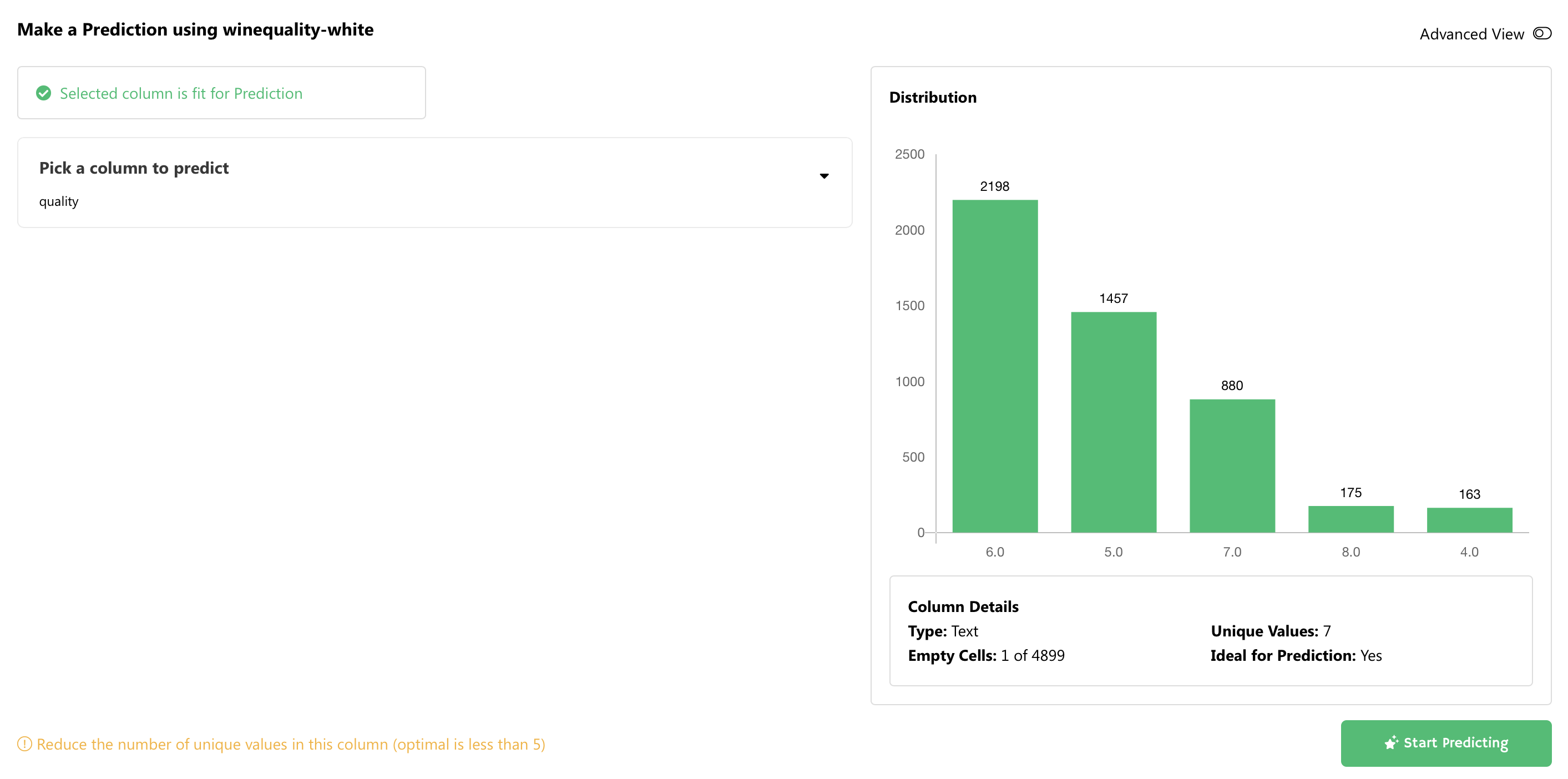
And that’s it! The service complains that we should reduce the number of unique values in the target variables, but we can ignore that. To finish, just click on the Start Predicting button. That’s all you have to do.
就是這樣! 服務抱怨說我們應該減少目標變量中唯一值的數量,但是我們可以忽略它。 要完成操作,只需單擊“ 開始預測”按鈕。 那就是你要做的。
The model is trained. Done. It’s that easy.
模型經過訓練。 做完了 就這么簡單。
That doesn’t mean that model is any good, so we’ll explore how it performed in the next section.
這并不意味著該模型有什么用,所以我們將在下一部分中探討其性能。
模型評估 (Model evaluation)
Once the model is trained, we’re presented with the report dashboard. It consists of a few areas:
訓練好模型后,我們將看到報告儀表板。 它包含以下幾個方面:
- Drivers 車手
- Personas 角色
- Export Predictions 出口預測
- Advanced Analytics 進階分析
- Tech Specs 技術規格
We’ll explore a couple of those here, the first being the Drivers area.
我們將在這里探索其中的兩個,第一個是“ 駕駛員”區域。
司機區 (Drivers area)
Put simply, this area tells us which variables are most important for forecasting, ergo which variables have the greatest prediction power. In our case, variables density, alcohol, and free_sulfur_dioxide are the top 3:
簡而言之,該區域告訴我們哪些變量對預測最重要,因此,哪些變量具有最大的預測能力。 在我們的案例中,變量density , alcohol和free_sulfur_dioxide是排名free_sulfur_dioxide變量:
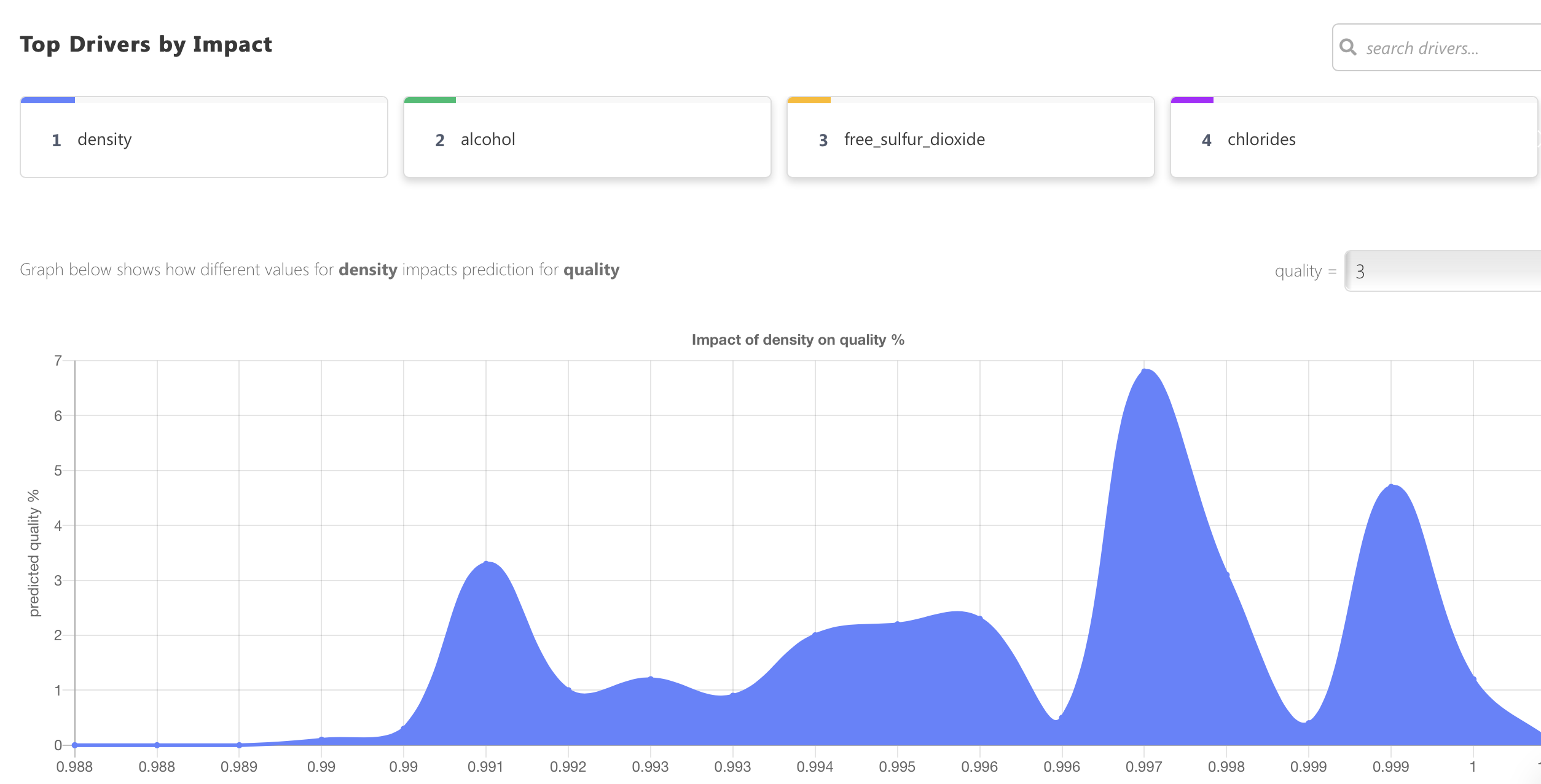
Nicely formatted and easy to understand. Let’s proceed.
格式正確,易于理解。 讓我們繼續。
出口預測區域 (Export Predictions area)
There’s no point in machine learning without making predictions on new, previously unseen data. That’s where the free version falls short, unfortunately. We can make predictions by uploading a CSV of previously unseen data — only attributes without the target variable.
如果不對以前看不見的新數據進行預測,則機器學習毫無意義。 不幸的是,這就是免費版本不足的地方。 我們可以通過上傳以前看不見的數據的CSV做出預測-僅包含沒有目標變量的屬性。
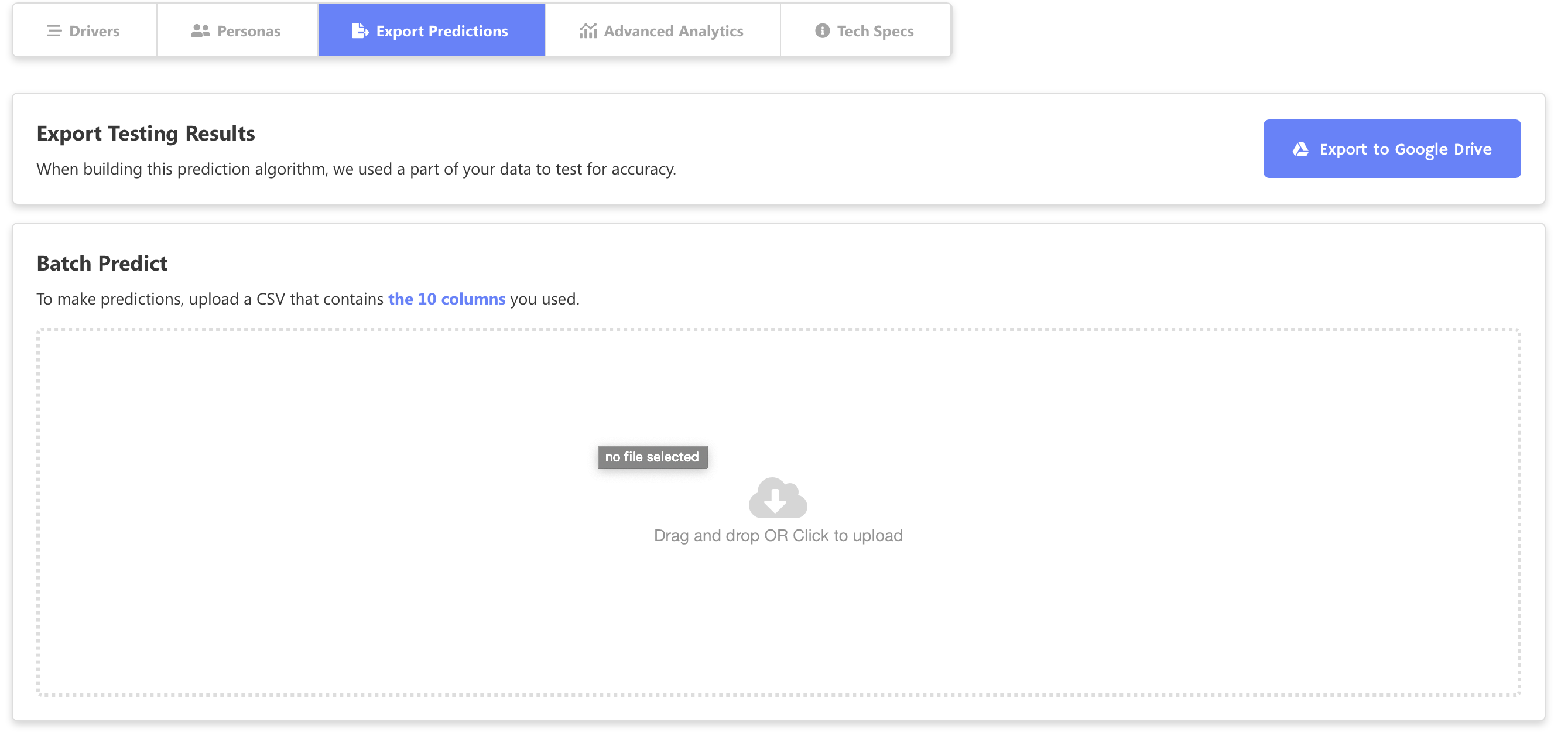
That’s all the free version offers. It might be enough for you, but I was expecting to see more.
這就是所有免費版本所提供的。 對您來說可能就足夠了,但是我希望看到更多。
What paid version gets you is deployed version of your model in the form of a REST API, which makes predictions that much easier to make from any programming language:
付費版本為您提供的是REST API形式的模型的已部署版本,這使得使用任何編程語言進行預測都變得更加容易:

This option isn’t supported in the free version, unfortunately, but can you blame them?
不幸的是,免費版本不支持此選項,但是您能怪他們嗎?
技術規格區 (Tech Specs area)
This area displays some basic information about the model, such as which algorithm was used, what was the accuracy on the train, test, and validation subsets, etc:
此區域顯示有關模型的一些基本信息,例如使用了哪種算法,訓練,測試和驗證子集的準確性如何,等等:

It’s a nice section to get a basic understanding of your model, but that’s it.
這是一個很好的部分,可以基本了解您的模型,僅此而已。
And that’s pretty much it for this introductory article to ObviouslyAI. Let’s wrap things up in the next section.
這就是ObviouslyAI的介紹性文章。 讓我們在下一節中總結一下。
你走之前 (Before you go)
In a nutshell, ObviouslyAI is obviously awesome, and such an easy service to recommend. For small to medium-sized businesses I can even see it as the only data science solution, maintained by one or more software developers that are training models with a couple of clicks and making predictions with API calls.
簡而言之, 顯然 AI很棒,而且推薦這種簡單的服務。 對于中小型企業,我什至可以將其視為唯一的數據科學解決方案,由一個或多個軟件開發人員維護,他們只需單擊幾次即可訓練模型,并通過API調用進行預測。
Data science teams could deliver a better solution, sure, but that team would potentially cost tens of thousands USD per month, where this solution is somewhere below $200 per month for the most expensive option. You do the math.
數據科學團隊當然可以提供更好的解決方案,但是該團隊每月可能花費數萬美元,而對于最昂貴的選擇而言,該解決方案每月的費用不到200美元。 你做數學。
It was obvious right from the start that data science will become just another flavor of software engineering, but it is services like this one that change the minds of even the most stubborn individuals.
從一開始就顯而易見,數據科學將成為軟件工程的另一種形式,但正是這種服務改變了即使是最頑固的個人的想法。
What are your thoughts? Have you tried ObviouslyAI? Feel free to drop your thoughts in the comment section.
你覺得呢?你有沒有什么想法? 您是否嘗試過ObviouslyAI? 隨時在評論部分中發表您的想法。
Join my private email list for more helpful insights.
加入我的私人電子郵件列表以獲取更多有用的見解。
翻譯自: https://towardsdatascience.com/introducing-obviouslyai-no-code-machine-learning-solution-da528c81071c
ai對話機器人實現方案
本文來自互聯網用戶投稿,該文觀點僅代表作者本人,不代表本站立場。本站僅提供信息存儲空間服務,不擁有所有權,不承擔相關法律責任。 如若轉載,請注明出處:http://www.pswp.cn/news/389088.shtml 繁體地址,請注明出處:http://hk.pswp.cn/news/389088.shtml 英文地址,請注明出處:http://en.pswp.cn/news/389088.shtml
如若內容造成侵權/違法違規/事實不符,請聯系多彩編程網進行投訴反饋email:809451989@qq.com,一經查實,立即刪除!

![[TimLinux] JavaScript 元素動態顯示](http://pic.xiahunao.cn/[TimLinux] JavaScript 元素動態顯示)







...)

![[微信小程序] 當動畫(animation)遇上延時執行函數(setTimeout)出現的問題](http://pic.xiahunao.cn/[微信小程序] 當動畫(animation)遇上延時執行函數(setTimeout)出現的問題)




)

